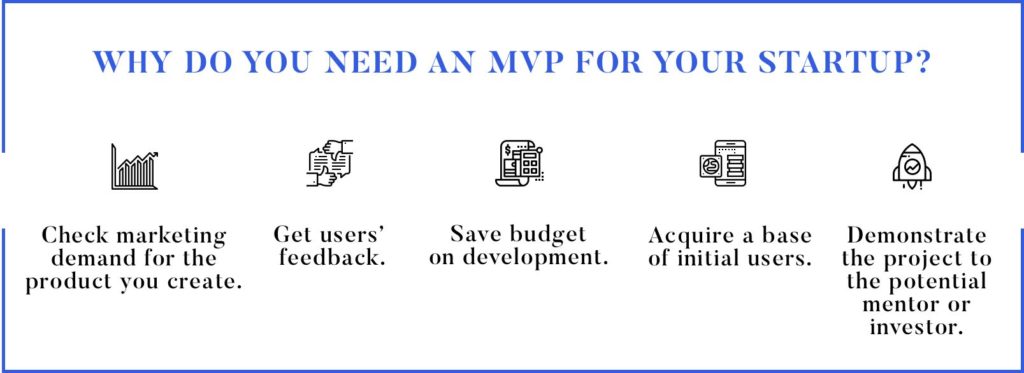MVP development meaning
The article continues the series of product development articles. In this one we would like to talk about MVP, its development, what is it for, and so on.
What is MVP
MVP stands for Minimum Viable Product. This a working version of product or service with minimum set of functionality. MVP is expected to perform something requested by a user.
An important special aspect here is that MVP doesn’t do anything more, anything additional to the given functionality, MVP performs actions to execute just a single task. In might be unclear right now, so let’s go further to come back to this point later.
Previously we have mentioned 3 steps of a so called Lean Startup methodology:
This approach has replaced by previously applied “product” approach. In general the product approach was common before the years 2000s and recommended creating the product first and then to sell it. There was a belief that if you created a good product, the customer would find you by default. Nowadays the situation has changed and founders apply lean startup approach to save time and budget and perform a customer development activities to find customers firstly. And creation of the MVP is one of such activities.
Why you need
The aims of an MVP development are usually the following:
- Check marketing demand for the product you create.
- Get users’ feedback.
- Save budget on development.
- Acquire a base of initial users (or a so called early adopters).
- Demonstrate the project to a potential mentor or investor.

Please pay attention that the main aim is No1, however MVP makes possible to achieve points 1-4 together.
As a result you will get understanding: do people really need your product, do they need this or that functionality spending not a lot of budget. MVP development is much cheaper than the development of the whole product or service and still makes possible to achieve the goals mentioned in previous points.
MVP development process
Before your team starts to develop MVP, make sure you have completed some theoretical preparation steps which include:
- Develop Lean Canvas (or Business Model Canvas);
- Begin at least some customer development activities;
- Identify target audience or at least some segments;
- Identify what problems (pains) your product is going to address.
Execution of these steps is a good basis for further MVP development, because to create a good MVP you need to understand clearly who will be a user and what pains can a user address using your MVP. In other words, these preparation steps make your MVP successful.
After the team has results of above mentioned steps, you can start MVP development. So assign a task to your developer or software partner and ask to develop the required functionality. Please note that the team has to develop the functionality that will serve only to address a single pain of a user.
The big challenge here is not to exceed the amount of functionality. For example, in case you are going to create a chatting application, MVP set of functionality will be: sign up/log in, send text message, receive text message. And that’s it. No support of delivery receipt, attachments (like pictures, videos, documents), colored text etc, everything additional will be developed later when you see the application is gaining user base. So when you start to create MVP, think of what to remove, and not what to add.
Please note also that MVP itself is all about testing hypothesis. A hypothesis is a statement that reflects the idea of your product or service. 
The main goal of MVP development is to test and validate the hypothesis. To be more precise, before creation of an MVP you should define metrics (or KPIs) that you will track and what metrics you need to achieve to recognize this MVP (as well as the given hypothesis) is successful. Regarding metrics, there are some basic ones, such as number of registrations, time spent in the application, retention rate etc., but metrics are unique for every single product and service and it is necessary to define them.
Ideally emerging startup should test 1 hypothesis every calendar week. In other words: 1 hypothesis defined – 1 MVP developed – 1 week of testing. Surely, depending on the product you are going to create this frameworks may be changed. But do not forget that modern startups are about speed. Speed of hypothesis management, its testing, speed of taking decisions, speed of go-to-market activities.
The process of MVP development may be stopped after successful testing which means that metrics or KPIs were achieved. In this case the team should analyze the results and make a decision of further development. If testing is unsuccessful and metrics were not achieved, so the team should generate one more hypothesis and develop one more MVP to test it. Surely, after analysis of the results of previous MVP.
Change of strategy after unsuccessful MVP development is called pivot. Pivot options are the following: change business model, change price, change technology, change target audience or its segment, change the product. Pivot is a common step of emerging startups and is about the ability to be flexible according to the market demands. This is about creating the product that the market really needs.
We wish you to be successful in your projects and initiatives. In case you still have questions regarding MVP development, do not hesitate to contact us. Code Inspiration works with startups as well as large companies and ready to provide you with consultancy and be your software development partner.
